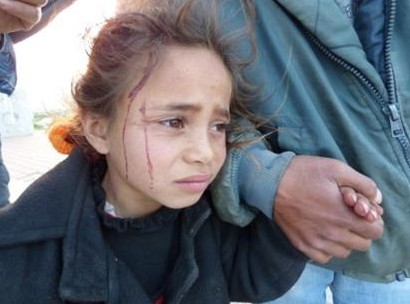Nonviolent
Resistance in the South Hebron Hills
By Cassandra Dixon

January 30,
2016 "Information
Clearing House"
- "Counterpunch"
- The worst worries of a child’s school day
should be homework. Maybe a lost book, or an
argument with a friend. No child’s walk to school
should routinely involve armed soldiers and fear of
sometimes being chased and assaulted by angry
adults. But for the Palestinian children who live
with their families in the small rural villages that
make up the South Hebron Hills, this is how the
school day begins. Illegal settlements and outposts
isolate and separate their villages and soldiers are
a constant in their lives.
Once, the
trip from the tiny hamlet of Tuba to the school in
the village of Tuwani was a calm and beautiful walk
along a quiet road connecting the two villages.
During the l980s Israeli settlers built a settlement
on privately owned Palestinian land, which had been
used to graze sheep and goats. Following
construction of the settlement, the settlers
established an illegal outpost. Now, industrial
chicken barns sit astride the road that once served
children walking to school, farmers taking livestock
to town, and families traveling to Tuwani, or the
larger town of Yatta for health care, shopping, and
higher education.
Between the
settlement and the outpost, what remains of the road
is closed to Palestinians. With one exception, –
children walk behind an Israeli military jeep to
reach their school. Their parents are not allowed to
walk with them.
The twenty
or so children who make this trip start their school
day in an unprotected field, anxiously waiting for
the Israeli soldiers who will oversee their walk to
school. Villagers had built shelters in which the
children could await the soldiers, but Israeli
authorities have dismantled every shelter. If it is
raining, the children get soaked. Some days the
soldiers are the same soldiers who chased or
arrested shepherds the day before – shepherds who
may be the brothers or fathers of these children.
Some days the soldiers are late, leaving the group
of children waiting, vulnerable to attack and within
easy reach of the outpost. Some days the military
escort does not arrive at all, and the children make
the trip to school with international volunteers
along a longer path, which also lies alongside the
settlement.
About 1,000
people live in the neighboring villages, an
estimated half of whom are children. Nevertheless,
because the villages lie inside of Israeli Firing
Zone 918, the military uses the land for military
training.
Amazingly,
despite all of this, it is almost unheard of for
children to miss a day of school. Parents are
determined that their children will be educated.
When I began volunteering in Tuwani, the school
reached only to third grade. Now thanks to the
community’s determination to provide their children
with education, students can complete high school in
the village, and although facing a continued threat
of demolition by Israeli military bulldozers,
villagers have built and staffed primary schools for
children who live in 8 nearby villages.
This is
what nonviolent resistance to military occupation
looks like.
I’m
grateful that I can spend a portion of this year in
Palestine. For many years children in these villages
have taught me about nonviolence. Sometimes, the
presence of international human rights workers
holding cameras has some small positive effect on
their days.
U.S. people
bear some responsibility for the interruption of
their childhoods. The U. S. subsidizes about 25% of
Israel’s military budget, at a cost to U.S.
taxpayers conservatively estimated at $3.1 billion a
year.
I’m working
with the Italian organization Operation Dove.
They
support Palestinians who resist the Israeli
occupation, standing with families in their
commitment to remain on their land. This includes
accompanying school children and farm families as
they walk to school, graze their animals and tend
their crops. Operation Dove helps document the
harassment, intimidation, arrests, detentions, home
demolitions, checkpoints, road closures, military
training exercises, and settler attacks. Villagers
also report to Operation Dove when they endure theft
and when their crops and property are destroyed.
Protective
presence provided by activists is not a large-scale
solution to the violence that intrudes into
childrens’ lives in Palestine. But many years of
visits with these families persuades me that it’s
important and necessary to support and participate
in the villagers’ nonviolent efforts. Families that
confront militarism and occupation help us move
beyond our addiction to militarism and violence.
The
children I met early on are grown now. Some have
gone on to college, and some have families of their
own. These young people have every reason to be
angry. Their childhoods included fear, intimidation,
demolitions, arrests and isolation. But they have
also grown up witnessing their community’s steadfast
commitment to nonviolently resist injustice. Their
families have supported them well, including them in
the community’s struggle for dignity. Against all
odds they are growing up with humor and tenacity
instead of anger and bitterness. They are living
proof to the rest of us that love wins.
To
read more about Operation Dove’s work in the South
Hebron Hills, visit
http://www.operazionecolomba.it/togetherattuwani
Photo Credit: Cassandra Dixon: “This
little girl was injured by two masked settlers who
attacked her with stones as she gathered herbs with
a friend on the path between Tuba and Tuwani. She
and her siblings make the same trip on foot each
school day. She is an amazingly smart and tough
young girl – insistent that the many odd volunteers
that pass through her life should learn her name and
visit her family’s home. She needed four stitches in
a head wound after the attack.”
|